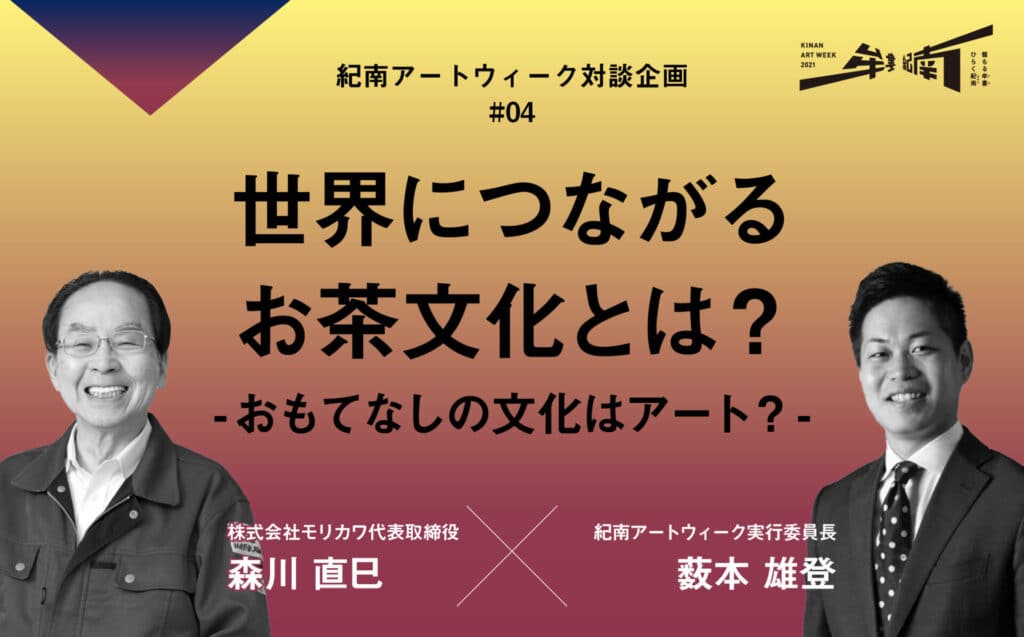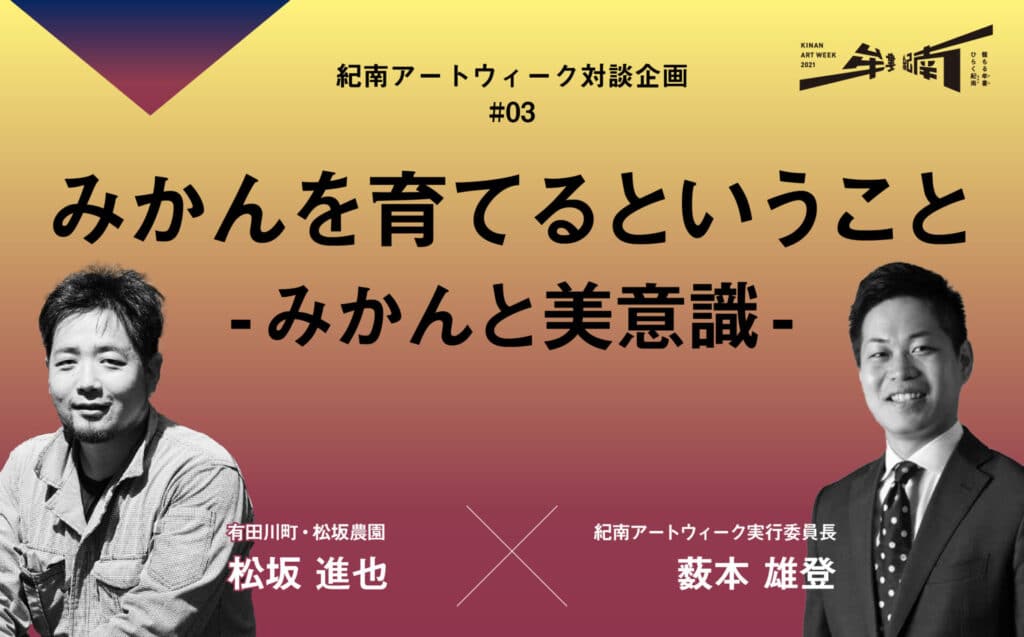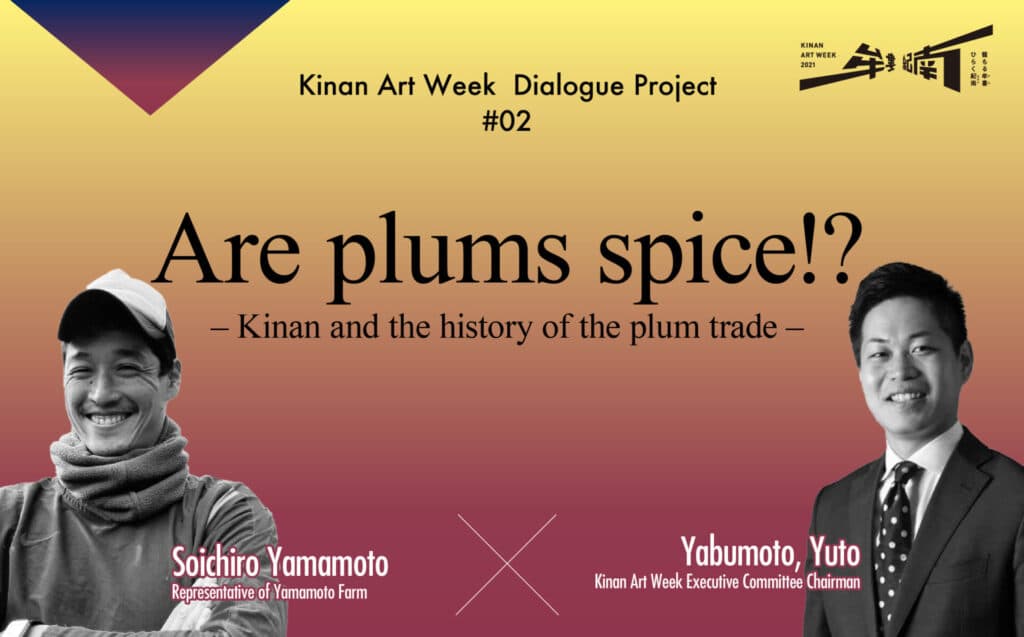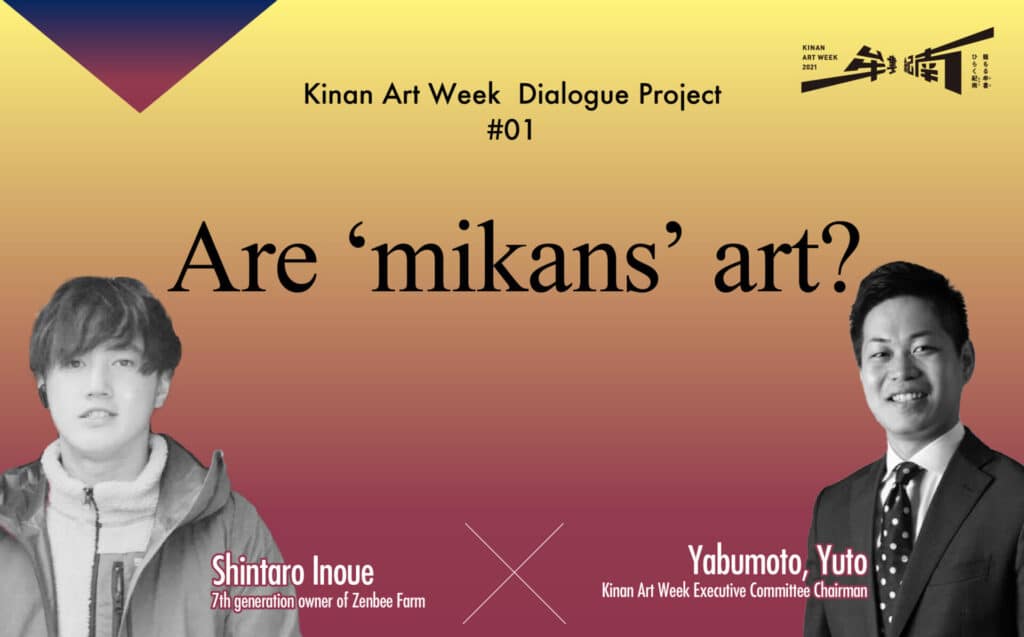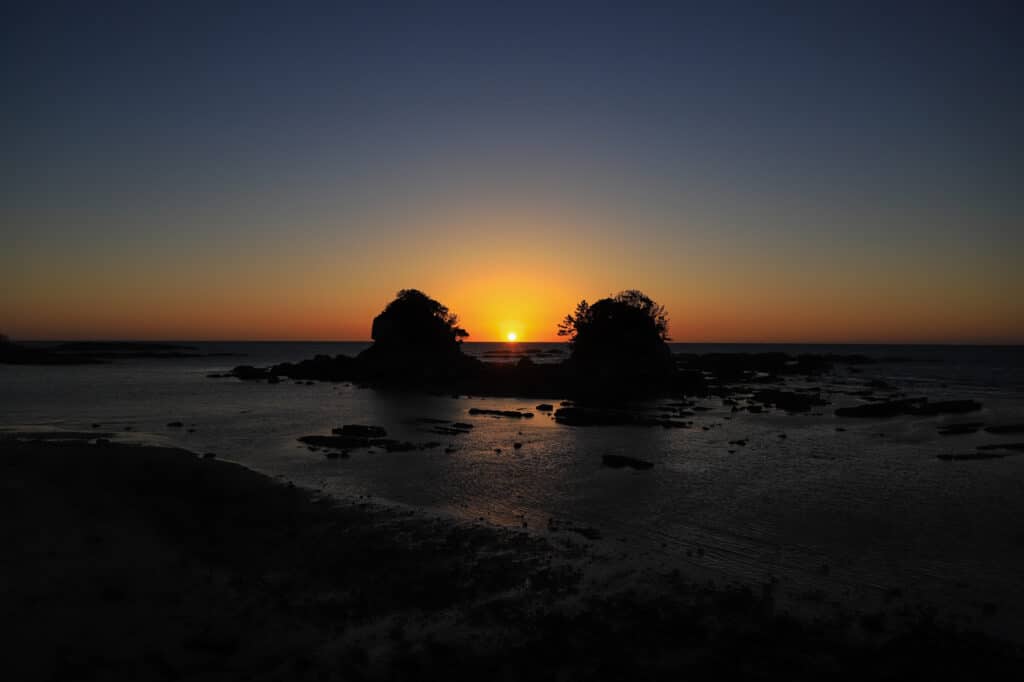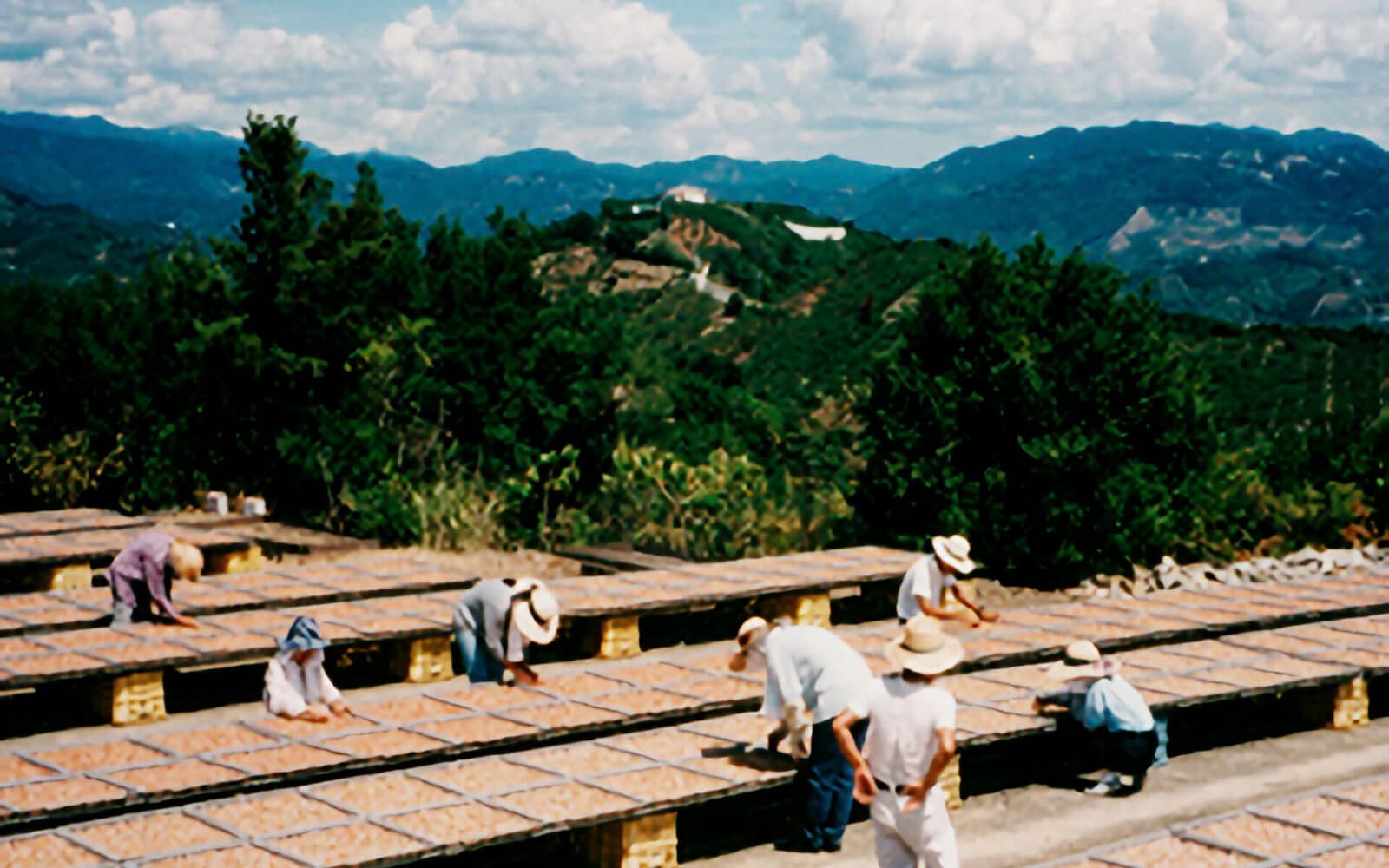
Dialogue project #5 “The origin of plum production in Kinan”
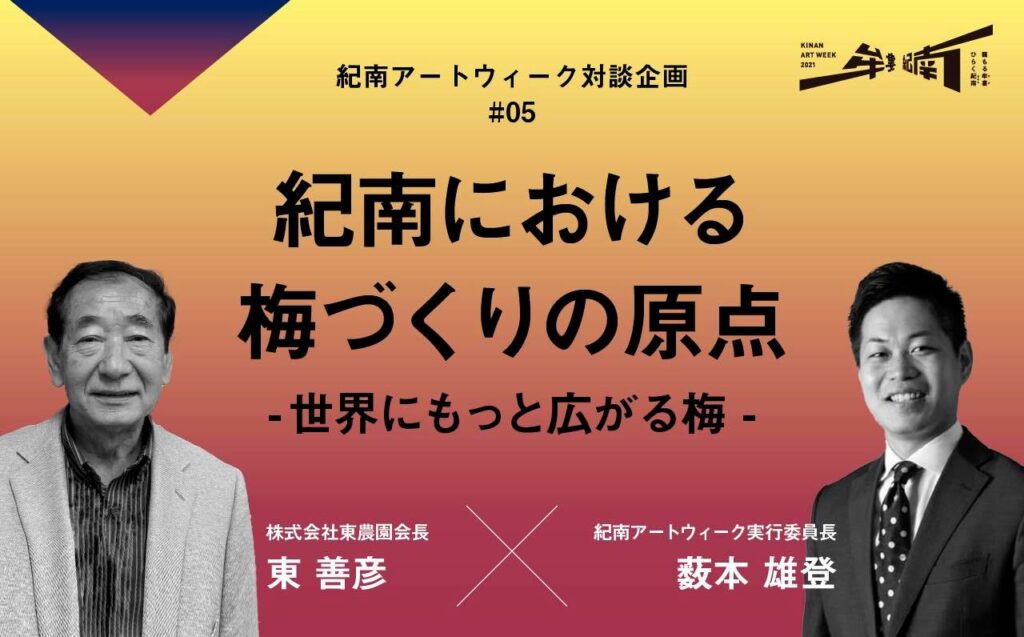
Kinan Art Week Dialogue project #5
Guest :
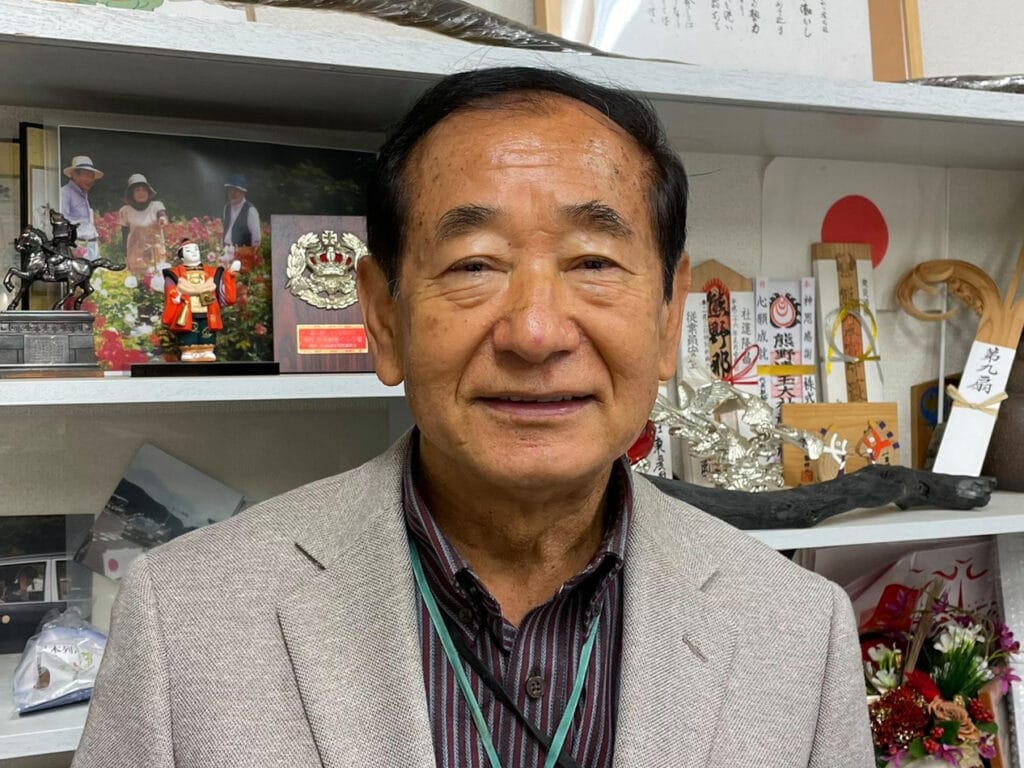
Chairman of Azuma Farm Corporation
Yoshihiko Higashi
Starting out as a Japanese plum (ume) farmer, he established the brand ‘Godaian’, a Kishu ume specialty shop. Since then, he has made it his lifelong commitment to passed on his wide knowledge and views regarding ‘Kinan Plums’.
https://www.godaiume.co.jp/
Interviewer :
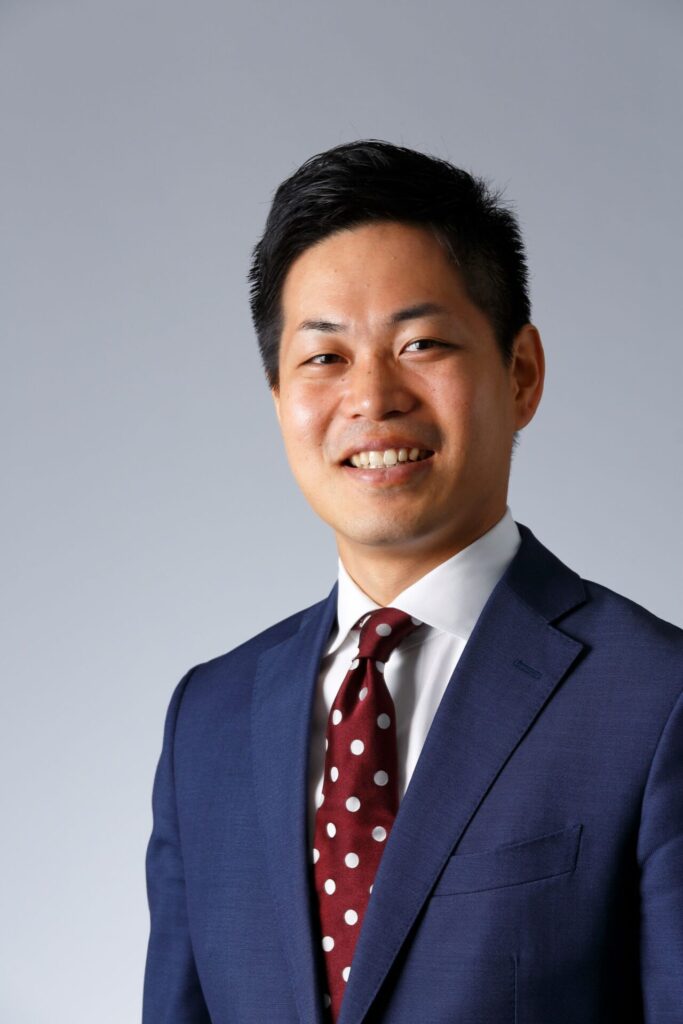
Kinan Art Week Executive Committee Chairman
Yuto Yabumoto
Editing :
Kinan Editorial Department by TETAU
https://good.tetau.jp/
The origin of plum production in Kinan
1. The history of pickled plums and plum vinegar
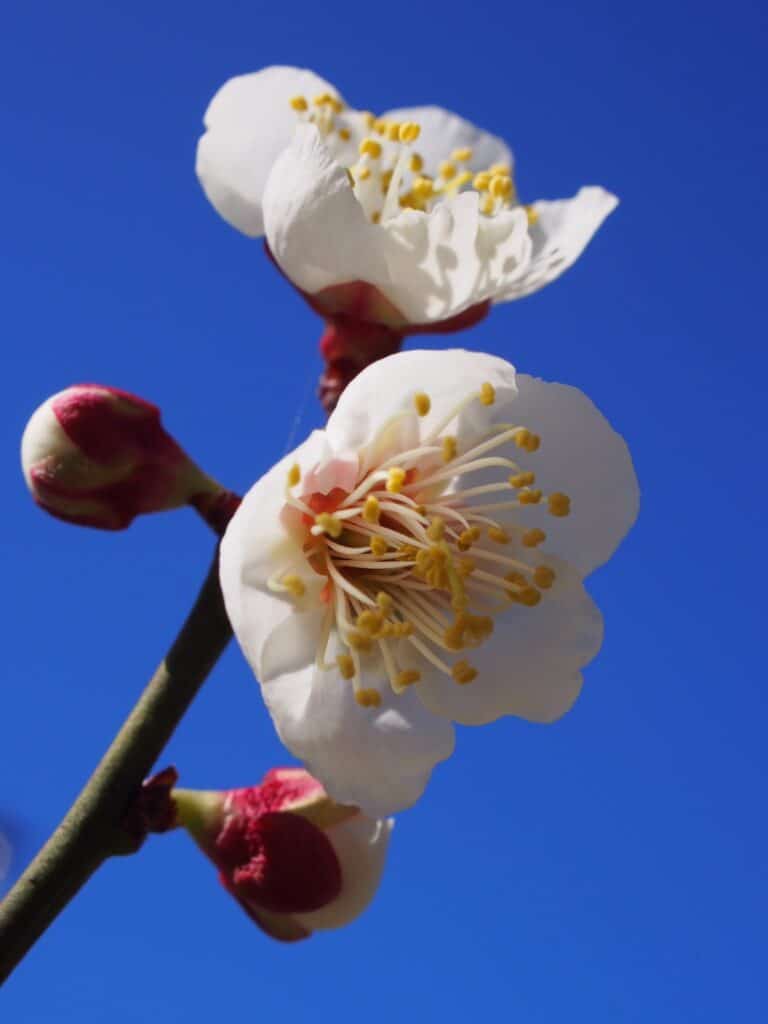
Mr. Yabumoto:
We were hoping to speak with a manufacturer of agricultural products in the Kinan region. Mr. Yanagimoto (a sales representative), a classmate of mine from the baseball club, connected me with you and I would like to thank him for the opportunity to meet with you today.
I would like to start by asking you a little bit about the history of Azuma Farm.
The company was founded in 1834. If we go further back, we hear that the family has a long history, dating back to 1723. Was it originally a farmhouse?
‘Yabuume’ was born from the policy of the Tanabe clan
Mr. Higashi:
Originally, the head family was the village headman in the Edo period. It was like the tax department of the Town Hall nowadays. We still have the records from that time. Nowadays, rice is grown in paddy fields, but at that time there was also rice grown on land (called okabo).
Tatewaki Ando, of the Tanabe clan, a branch of the Kishu clan, had a policy of not charging any tribute for rice grown on land (tax exemption encouragement). So the people of this area cut down bamboo groves to plant rice and also planted plum trees on the same land. At that time, the plums were called ‘Yabu-ume’. The plums were made into pickled plums (umeboshi) and offered to the Tanabe clan.
It can be said that the Kishu clan, which has many mountain forests, has a ‘300 years history of sending plums to Edo,’ along with cedar and cypress wood. This whole area has a warm climate because it is adjacent to the sea. There are mountains, waters, and in addition, although the land is quite barren with acidic soil, all of these factors are good conditions for cultivating plums. So plums in this area are probably the best in Japan. In 2015, the area was designated as a World Agricultural Heritage Site as part of the ‘Minabe/Tanabe Ume System’.
Mr. Yabumoto:
If you look at the history of plums, they are said to have come from China in the Heian period. It was the policy of the Kishu clan (Tokugawa) and the climate of Kinan that turned it into a major production area.
Plums are a part of Japanese life
Mr. Higashi:
It was after the war that it developed significantly. During the war, soldiers took pickled plums (umeboshi) with them to the battlefields. Even as far back as the Warring States period, plum pulp, sugar and rice flour were mixed together to make dumplings called ‘ikiai no ume’. They were kept inside the soldiers’ armor and eaten when they were tired, to stay fit. It seems that the Japanese people have had a close and inseparable relationship with plums.
It is also said that ‘Umeboshi and Japanese swords’ are typical items which were born from Japan’s unique wisdom.
Mr. Yabumoto:
If you look up a proverb like ‘inside the core of a fresh plum lies a heavenly deity’ , ‘a plum keeps the trouble a way’ , or a word such as ‘anbai’ (塩梅=salted plum), you will find that there are many words relating to plums and the Japanese people.
Mr. Higashi:
Yes, that’s right.
It is said that plums were introduced from China. At that time, the plums were processed by steaming them, and were called ‘Ubai‘ (crow-plum) because they were black like a crow. Pickling plums in salt is unique to Japanese culture. It is said that the plum vinegar produced by pickling in salt was used as a seasoning. In fact, the plum vinegar came first and pickled plums (umeboshi) came second.
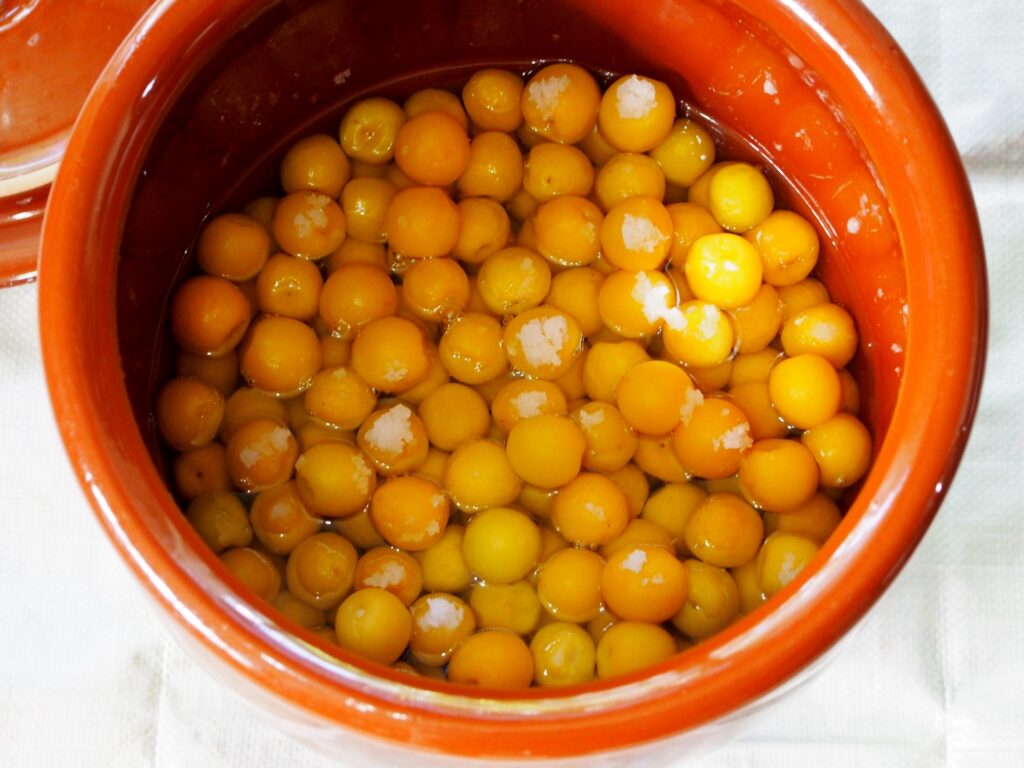
Mr. Yabumoto:
Exactly!
Today, the focus is on ‘umeboshi’(pickled plums), but in fact I think that plums can be talked about on the same level as salt and pepper, which are part of Japan’s trading history. I suppose that plums were also used for food preservation and transported from Tanabeura and Tondaura.
Mr. Higashi:
Nowadays there are many different types of seasonings, but in the past plum vinegar was very important.
In this area, pickled plums are made by soaking about 50,000 to 60,000 ton of raw plums and can produce 10,000 ton of plum vinegar. A cookery expert said: “There is no other seasoning available in such large quantities!” So it was commercialized and is now being sold. We believe that plum vinegar has a great future as a seasoning.
Mr. Yabumoto:
Based on the history of trade, we believe that plums, along with salt and pepper, can be exported as a type of seasoning and spice, to the whole world.
Mr. Higashi:
I think that exporting is essential for our company and our production area. We feel that the market in Japan alone has its limits.
Mr. Yabumoto:
In this sense, I would like to dig deeper into the question of why pickled plums (umeboshi) were something that Japanese people could relate to, and why they became so popular in Japan.
Mr. Higashi:
In the old days, when we were poor and had no side dishes, we ate rice with only umeboshi (pickled plums). Umeboshi must have been the quickest way to eat.
Umeboshi also acted as a medicine. In the Edo period, it seems that many people died of starvation due to famine, but there is a record in the Kishu domain that not a single person died of starvation. There is also a theory that Siebold brought back ‘umeboshi’ as a Japanese medicine in the Edo period.
In this day and age, plum vinegar can be diluted and used as a gargle. It is also safe because it is a natural product. From now on, I would like to recommend plum vinegar to people all over the world. In Kinan, we have a lot of history, culture, wisdom and raw materials for the effective use of ‘ume’ (Japanese plums).
2. The birth and future of Godaian
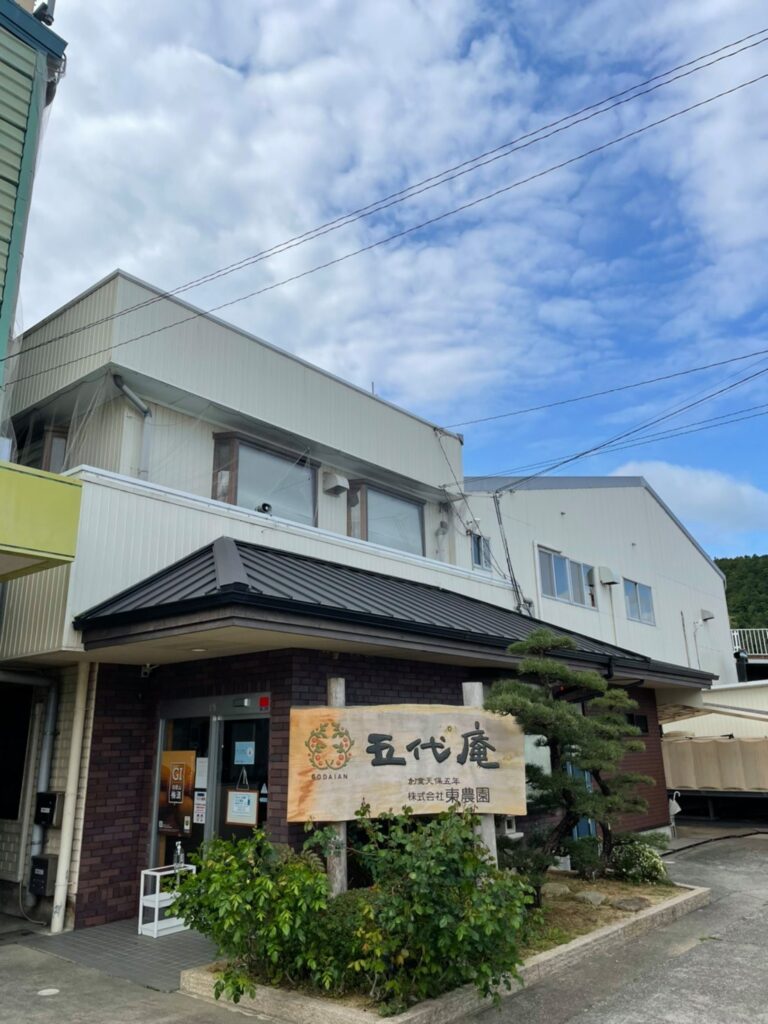
Mr. Higashi:
I am the eldest son, so I was told that I should take over the family business. After graduating from high school, I didn’t go to university. I worked in a bank for three years, and what I learned there has led me to where I am today.
Supermarkets started to open in the 1950s so farmers used to put their pickled plums in barrels and send them to wholesalers. Then supermarkets started selling the pickled plums in 50 or 100g packs. Gradually, pickled plums have become popular due to health consciousness, and plum liqueur, which is called ‘green diamond’, has also become very popular.
In my family, we used to do all sorts of agricultural things: grow rice, raise cows, and cultivate plums. The sixth industry, from processing to sales, started in my generation. Thanks to my contacts at the bank, we were able to get our products sold in supermarkets. Nowadays there are processors who import plums from China and Taiwan, but we have branded ourselves as dealing only with domestic plums. I am the fifth generation of the family, so we named our business ‘Kishu Godai (the fifth generation) Ume, Godai-an’.
Mr. Yabumoto:
So that’s what it was!
It was only from the fifth generation that you became a manufacturer. So you are the founder, right?
Plums, who married into Japan from China, “have become splendid and want to return home”
Mr. Higashi:
I knew I couldn’t do it as a farmer alone, and my personality wanted to get out there. I wasn’t satisfied with just making pickled plums, and I wanted to add value to my plums. Of course, I’ve made a lot of mistakes.
My challenge for the future is to achieve zero waste. If we can produce plum vinegar and other products without any waste, we will finally be able to say that we are the highest production area in Japan for the first time.
I think the plum tree married into Japan from China and is saying: “I want to go back home to China because I have become splendid and independent in Japan”. The plums will spread more in the world. It is recognized as an agricultural heritage, but it is not enough to be a ‘heritage’. We have to create the ‘future’. We need to think about how to market our products, not only in Japan but also overseas. I think it is very important to add value and to protect the brand.
Mr. Yabumoto:
When I think about what art is from a branding point of view, I think of the Eastern idea of art: if it moves you, it is art.
Farmers are able to live their lives by looking at the whole picture and optimizing it. It means they are truly artists, and farmers would like to see a world where their value is understood to the fullest. I am wondering if it is possible to make art itself, whether they are pickled plums or plum products.
Mr. Higashi:
It’s about quality, but it’s also about how we re-consider added value.
If we think about current dietary habits, I think there is an increase in the number of consumers who want to have something good in their daily lives, even if it is just slightly better. If we can reach out to them, I believe it will be even better for us as a plum producing region.
3. The essence of plums to be shared with the whole world
Mr. Yabumoto:
This is a fundamental question: Does eating plums contribute to people’s happiness today? What does it mean, ‘to contribute to society through plums’ as written on your website?
“Pickled plums are the Earth itself”
Mr. Higashi:
The Chinese character for ‘plum’ (梅) comes from China. This can be interpreted as a ‘mother tree’, and what is born from that is ‘plum fruit’. The Chinese character for ‘sea’ (海) also means ‘mother water’. Our body is close to seawater, 60% of which is water. Also there is even a theory that mankind was born from the sea, and the crystals of this seawater are salt. The combination of ‘ume’ and ‘salt’ is what makes ‘umeboshi’ and ‘plum vinegar’. Let me add one more thing, plums are products of the land; salt is a product of the sea. Land and sea, this is the Earth.
When I thought about this, I thought it was such a great concept. So I always talk about it whenever I have Japanese or overseas’ customers.

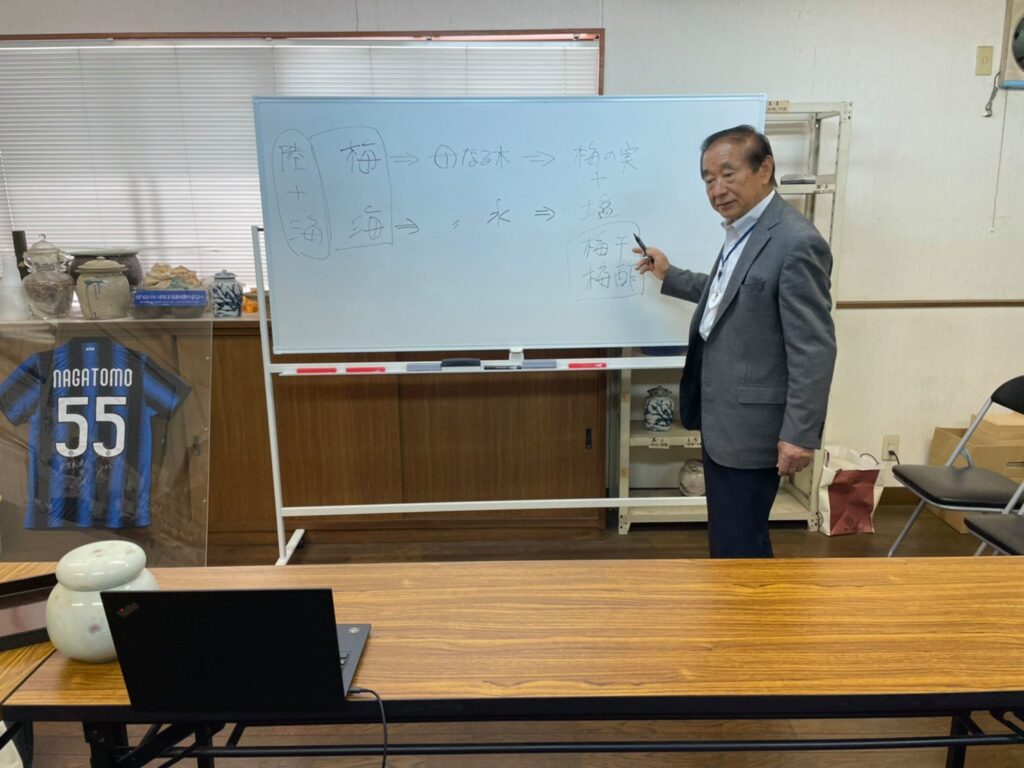
Mr. Yabumoto:
It’s totally wonderful!!! I want to tell the world about it!
Mr. Higashi:
We believe that we are making something truly wonderful. More to the point, if you decipher the word ‘food’(食), it means ‘good for people’. It is agriculture that is for the human body, isn’t it? To protect agriculture is to protect the country. ‘Agriculture is food’. I believe that this is the very foundation of our work.
Mr. Yabumoto:
I think it’s something that people all over the world can relate to together.
Mr. Higashi:
I believe that promoting plums, plum vinegar and good Japanese products, is good for us and good for the farmers.
On the other hand, in our industry, there is a reluctance to sell abroad.
Mr. Yabumoto:
I think that localization in different parts of the world is a strength of large companies and a limitation for small and medium-sized companies. Also, even if you localize your business, if the money doesn’t come back to Japan, there is no point. In this sense, I think that direct export from Kinan is actually very important for the maintenance and development of Kinan. There are people who will be moved just by telling the world what you have just said, and I think that is an art in itself.
I think it is extremely important to tell people about cultural values and stories, not just about technology.
Mr. Higashi:
It’s not good if someone who says ‘it’s so good’ gets sick. (Laughs)
Yabumoto:
You look totally fine to me. (Laughs)
4. What we will leave for Kinan in 100 years

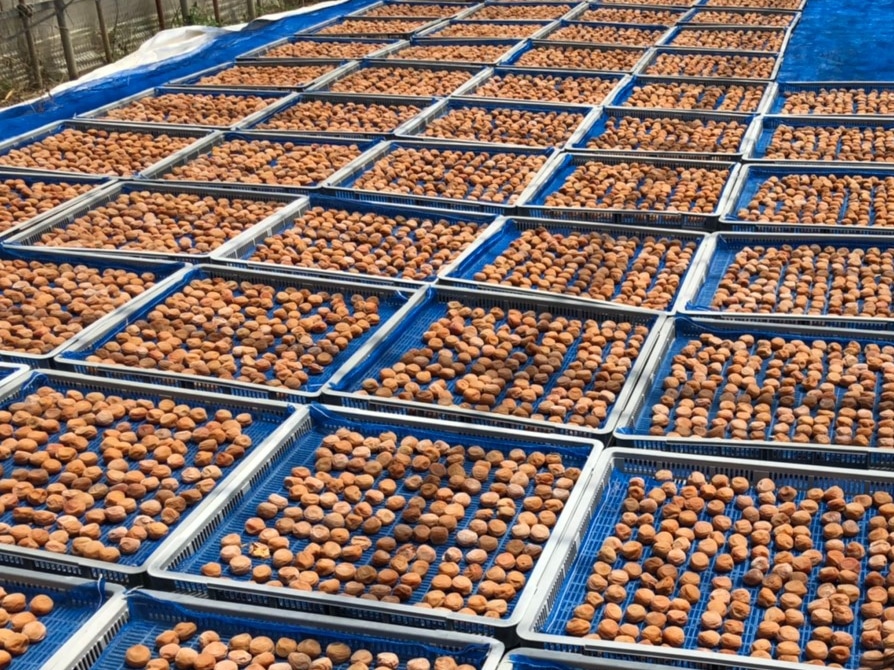
Mr. Yabumoto:
On your website you also mention ‘food and mind’, how do you see ‘mind’?
Mr. Higashi:
It’s about providing good products to our customers, making them happy, and through that, making ourselves happy. Now we call this area ‘Minabe-town’, but we used to call it ‘Minabegawa-village’. There was a time when I didn’t want to say “I live in a village”, but now I can proudly say “I live in the countryside” or “I live in the mountains”. It’s that kind of ‘mind’ that makes all the plums circulate and doesn’t do anything that doesn’t satisfy me.
Mr. Yabumoto:
That’s exactly where the ‘aesthetics’ come in.
Mr. Higashi:
Most of the pickled plums sold in Japan today are dried in the sun. Ultraviolet rays from the sunlight enter the pickled plums and turn them red. Machine-drying cannot produce this color. It’s very hot and difficult during the summer airing season, but we don’t mind working outside because we are covered in salt and absorb the scent of the plums while drying them.
At Godaian, the only work done by machine is the selection of the plums according to size. Everything else is done by hand, which is another advantage. I think this is one of the things that will remain unchanged in order to produce good plums, both in the Edo period and in the next 100 years.
Mr. Yabumoto:
I wanted to finish by talking about what will happen in 100 or 300 years time. I suppose it doesn’t have to be pickled plums and it’s good enough if the culture and essence of plum making remains there.
Mr. Higashi:
And our dietary habits are changing.
Plums may be a favorite food in our diet, or a functional food that is good for our health.
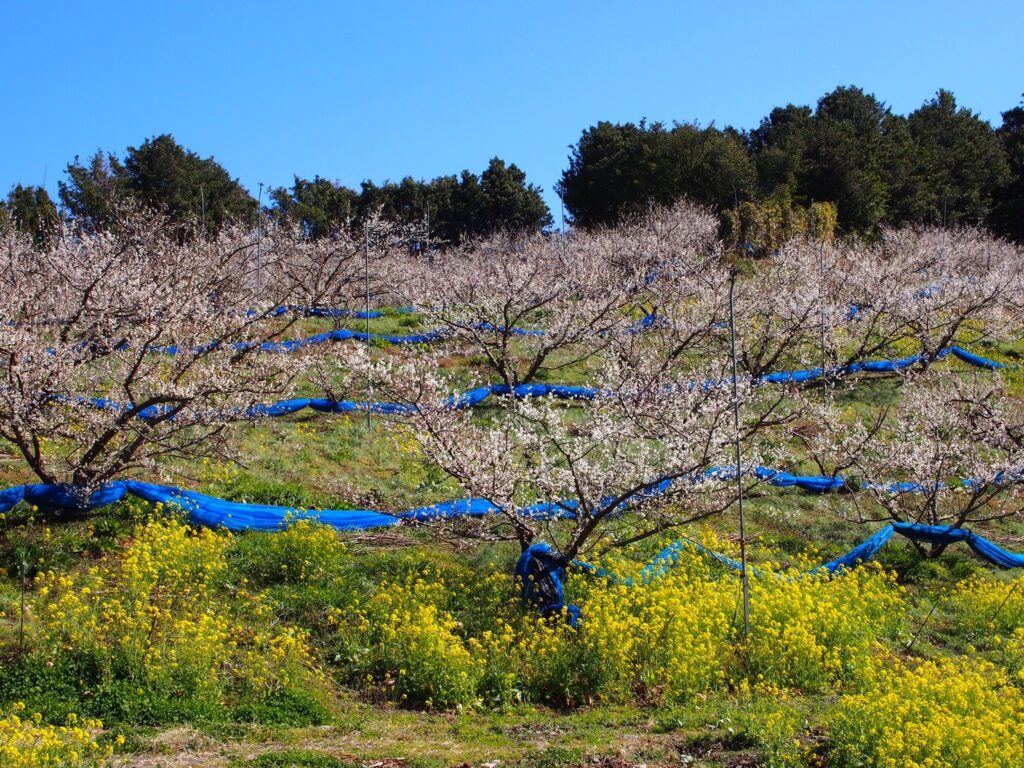
Mr. Yabumoto:
As global warming progresses, there may come a time when agriculturally growing plums in Kinan is not the right choice. At such a time, we believe it is important to delve into the question of why people in Kinan grow plums, and to make the way people in Kinan are, into a value.
Mr. Higashi:
It is how we accept the changes caused by global warming, isn’t it?
No matter how advanced the times are, we cannot control the climate. Agricuture is always a struggle against climate change. In 1965, our production area became the largest in Japan, when the plum variety ‘Nanko-ume’ was created by unifying many other varieties.
In order for our Kisyu to continue to be the best in Japan, we are now working together with the public and private sectors to develop varieties of ‘new Nanko ume’ that can grow in any environment. We believe that this will become a reality in the near future.
Mr. Yabumoto:
It’s about how we convey the concept and value, isn’t it? I think it’s important to say: ‘Why do Japanese people eat umeboshi?’ and ‘Kinan people are interesting people’.
Mr. Higashi:
Surely, that’s enough for us.
Over the past 10 years, I have collected about 10,000 books and historical documents that describe plums.
I would like to collate ‘the history of plums: past, present and future’ into a book, which is about how the area has become Japan’s highest producing district.


Mr.Yabumoto:
Localization reduces the value of a thing. The players who are selling something of real value are selling its intrinsic value to the whole world.
By telling the story of Godaian, its close to 400 years of history and why it exists in Kinan, I believe that people will definitely be moved. I think it is the greatest pleasure for human beings to be able to preserve their culture, just like buying art.
Today, I was particularly interested in the meaning of the Chinese character for ‘plum’ (梅). The word ‘plum’ itself is very universal, and I think just telling people about it is enough to make them say: “So that’s what it means!”
Thank you very much for giving us so much time. I learnt a lot.
Mr. Higashi:
Thank you too.
If you ever come here again, I will be happy to talk with you.
.

